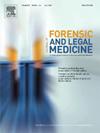使用计算机断层扫描对古人类骨骼遗骸进行多学科分析:意大利Cumae的一个案例研究
IF 1.2
4区 医学
Q3 MEDICINE, LEGAL
引用次数: 0
摘要
放射学是人类学中重要的临床方法,为古代人类遗骸提供最小破坏性的检查。考古学家经常依靠放射学来分析人类学和病理学发现,而不会破坏考古发掘的骨文物,包括那些打算在博物馆展出的文物。在骨考古研究中,成像在评估骨骼的人类学和病理学方面起着至关重要的作用,提供了对性别、死亡年龄、身材和各种病理(如感染、肿瘤和创伤)的见解。这项研究在那不勒斯的“Luigi Vanvitelli”大学医院进行,重点分析了从库梅卫城(意大利坎帕尼亚)出土的人类骨骼遗骸,促进了考古学家、具有代谢性骨病管理专业知识的物理和康复医学医生(即物理医生)和放射科医生之间的合作。该研究旨在利用先进的成像技术识别和评估骨骼遗骸的人类学和病理学特征。同时,强调了多学科合作在古代遗骸综合分析中的作用,为今后的研究奠定了基础,以提高该领域的知识水平。材料与方法利用传统的射线摄影(CR)和计算机断层扫描(CT)对库迈基督教堂墓地的人类遗骸进行了分类和检查。对骨碎片进行CT扫描以评估完整性、密度改变、骨折和病理。每个骨碎片单独分析,保持解剖方向。选择性病例采用双能CT (DECT)扫描,增强骨病变的检测。结果考古学家和放射科医生的合作促进了骨骼碎片的重建和鉴定。CT分析显示了不同病例的不同表现,包括骨折、骨硬化区和退行性改变。CT扫描的详细观察与x射线检查相辅相成,有助于全面的骨骼分析。古放射学,创造于1987年,随着CT的进步而发展,使对古代遗骸的微创检查成为可能。与传统的x线摄影相比,CT成像提供了更高的分辨率和细节,有助于识别细微的病理。多学科合作提高了诊断的准确性,并确保了全面的分析。结论sct分析提供了详细的骨完整性和病理信息,便于全面的人类学检查。多学科合作对于准确解释古代人类遗骸至关重要。这项研究代表了一个初步阶段,为进一步研究形态-密度特征奠定了基础。本文章由计算机程序翻译,如有差异,请以英文原文为准。
Multidisciplinary analysis of ancient human skeletal remains using computed tomography: A case study from Cumae, Italy
Background
Radiology is a pivotal clinical method in anthropology, offering minmally destructive examination of ancient human remains. Archaeologists frequently rely on radiology to analyse anthropological and pathological findings without damaging osteological artifacts from archaeological excavations, including those intended for museum display. Imaging plays a critical role in assessing anthropological and pathological aspects of bones in osteoarchaeological studies, providing insights into sex, age at death, stature, and various pathologies such as infections, and neoplasmas, and trauma. This study, conducted at the University Hospital "Luigi Vanvitelli" in Naples, focuses on analyzing human skeletal remains excavated from the Acropolis of Cumae (Campania, Italy), fostering collaboration among archaeologists, physical and rehabilitation medicine physicians (i.e., physiatrists) with expertise in the management of metabolic bone diseases,and radiologists. The study aims to identify and assess anthropological and pathological features of skeletal remains using advanced imaging techniques. Additionally, it highlights the role of multidisciplinary collaboration for comprehensive analysis of ancient remains, laying the basis for future research to improve knowledge in this field.
Materials and methods
Human remains from the cemetery of the Christian Basilica of Cumae, were catalogued and examined utilizing conventional radiography (CR) and computed tomography (CT). CT scans were conducted on bone fragments to assess integrity, density alterations, fractures, and pathologies. Each bone fragment was analyzed separately, maintaining anatomical orientation. Dual-energy CT (DECT) scans were employed in select cases, enhancing bone lesion detection.
Results
The collaboration between archaeologists and radiologists facilitated the reconstruction and the identification of skeletal fragments. CT analysis revealed diverse findings across cases, including fractures, osteosclerotic areas, and degenerative changes. Detailed observations from CT scans were complemented by X-ray examinations, contributing to comprehensive skeletal analyses.
Discussion
Paleoradiology, coined in 1987, has evolved with CT advancements, enabling minimally invasive examination of ancient remains. CT imaging offers superior resolution and detail compared to conventional radiography, aiding in the identification of subtle pathologies. Multidisciplinary collaboration enhances diagnostic accuracy and ensures comprehensive analyses.
Conclusions
CT analysis provides detailed insights into bone integrity and pathologies, facilitating comprehensive anthropological examinations. Multidisciplinary collaboration is essential for accurate interpretations of ancient human remains. This study represents a preliminary phase, laying the groundwork for further investigations into morpho-densitometric characteristics.
求助全文
通过发布文献求助,成功后即可免费获取论文全文。
去求助
来源期刊

Journal of forensic and legal medicine
MEDICINE, LEGAL-
CiteScore
2.70
自引率
6.70%
发文量
106
审稿时长
57 days
期刊介绍:
The Journal of Forensic and Legal Medicine publishes topical articles on aspects of forensic and legal medicine. Specifically the Journal supports research that explores the medical principles of care and forensic assessment of individuals, whether adult or child, in contact with the judicial system. It is a fully peer-review hybrid journal with a broad international perspective.
The Journal accepts submissions of original research, review articles, and pertinent case studies, editorials, and commentaries in relevant areas of Forensic and Legal Medicine, Context of Practice, and Education and Training.
The Journal adheres to strict publication ethical guidelines, and actively supports a culture of inclusive and representative publication.
 求助内容:
求助内容: 应助结果提醒方式:
应助结果提醒方式:


